16 Bar Design Ideas for Business Owners to Inspire You
- Sophia Mitchell

- Aug 6
- 10 min read
Updated: Sep 30
Transform your bar with 16 innovative design ideas. From speakeasy themes to rooftop concepts, create spaces that boost profits.

Picture this: a customer walks into your bar, stops mid-step, pulls out their phone, and immediately starts snapping photos. That's the power of exceptional bar design! In today's Instagram-driven world, your bar's aesthetic isn't just about looking pretty; it's about creating an experience that turns first-time visitors into regulars and transforms your space into the neighborhood's hottest destination. Whether you're launching a new venue or breathing fresh life into an existing establishment, the right design can make or break your business. But here's the thing: great bar design goes beyond trendy wallpaper and Edison bulbs. It's about crafting an atmosphere that tells your story, maximizes your space, and keeps those cash registers singing. Ready to discover design ideas that'll make your competition nervous? Let's dive into 16 innovative concepts that blend style with functionality, turning your bar into a profit-generating masterpiece.
1. Industrial Chic: Raw Appeal Meets Modern Comfort
Transform your space into an urban oasis by embracing the industrial chic aesthetic that's dominating the hospitality scene. Exposed brick walls, concrete floors, and visible steel beams create an authentic warehouse vibe that resonates with modern customers seeking genuine experiences. Mix these raw elements with warm wood accents, plush leather seating, and soft Edison bulb lighting to balance comfort with edge. The beauty of industrial design lies in its cost-effectiveness; many elements you'd typically hide become featured attractions. Consider incorporating reclaimed materials like old factory windows as dividers or repurposed machinery as decorative elements. Metal bar stools with worn leather seats, copper pipe shelving systems, and distressed wood communal tables complete the look. This design approach particularly appeals to millennials and Gen Z customers who value authenticity over polish. Plus, the durable materials handle high traffic beautifully while requiring minimal maintenance.
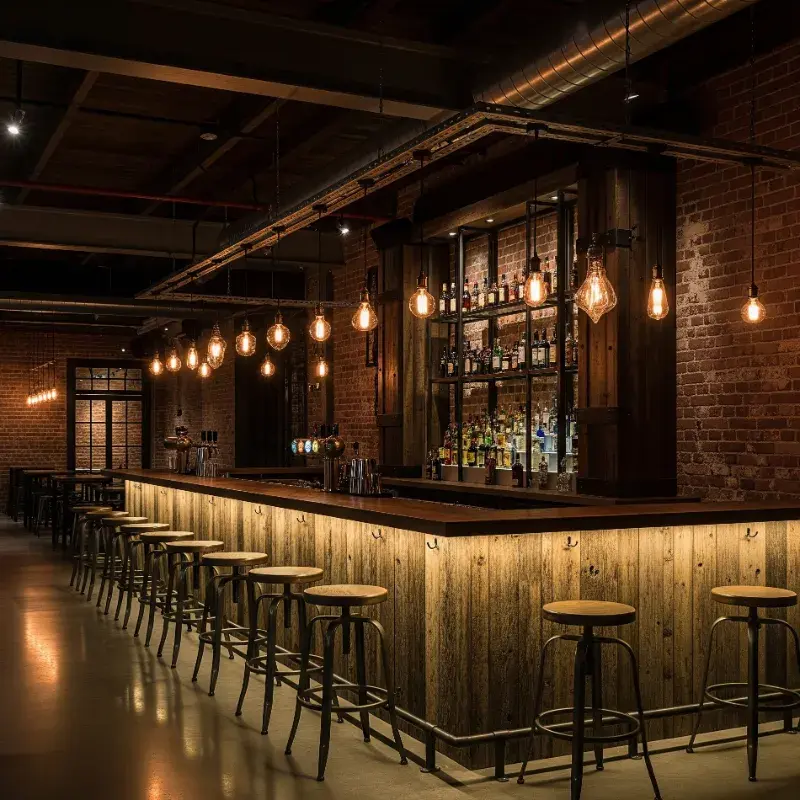
2. Speakeasy Style: Hidden Gems and Secret Entrances
Create an air of mystery and exclusivity by designing your bar as a modern speakeasy that channels the rebellious spirit of the Prohibition era. Start with a disguised entrance: perhaps through a bookshelf, behind a phone booth, or via an unmarked door that requires a password. Inside, design intimate spaces with rich velvet curtains, dark wood paneling, and vintage brass fixtures. Keep lighting dim and moody with art deco-inspired fixtures and candles on tables. Incorporate design elements like tin ceilings, hexagonal floor tiles, and a stunning back bar featuring antique mirrors and glass shelving. Train staff to dress in period-appropriate attire and craft cocktails using vintage techniques and presentations. The exclusivity factor drives social media buzz and creates loyal customers who feel part of an elite club. This concept works especially well in urban areas where the thrill of discovery adds to the overall experience.

3. Tropical Paradise: Bringing the Beach to Your Bar
Transport customers to an island getaway without leaving the city by creating a tropical paradise that appeals to all senses. Install a retractable roof or large skylights to flood the space with natural light during day service. Use natural materials like bamboo, rattan, and reclaimed teak for furniture and fixtures. Create different zones with thatched-roof tiki huts, suspended egg chairs, and communal surfboard tables. Living palm trees, bird of paradise plants, and hanging ferns blur the line between indoors and outdoors. Add sensory elements like the sound of waves through hidden speakers, tropical scents through diffusers, and sand-textured flooring in certain areas. Design the bar itself as a massive tiki structure with carved details and integrated lighting. This immersive approach works year-round, offering summer vibes even in winter months. The photogenic nature of tropical design generates free marketing through customer social media posts.

4. Living Wall Features: Green Design That Breathes
Incorporate living walls that transform blank surfaces into breathing ecosystems while improving air quality and acoustics. These vertical gardens range from simple herb walls behind the bar (functional for cocktail garnishes) to elaborate artistic installations spanning entire walls. Choose low-maintenance plants like pothos, ferns, and succulents that thrive in indoor conditions. Install integrated irrigation systems and LED grow lights to ensure plant health without constant maintenance. Design considerations include waterproofing, drainage, and accessibility for plant care. Living walls create natural conversation starters, provide Instagram-worthy backdrops, and demonstrate environmental consciousness that resonates with eco-aware customers. Position seating to take advantage of these green focal points, creating intimate garden-like nooks within your bar. The psychological benefits of biophilic design include reduced stress and increased well-being, encouraging customers to stay longer and return more frequently.

5. Multi-Level Layouts: Maximizing Vertical Space
Revolutionize your floor plan by thinking vertically with multi-level designs that create distinct experiences within one venue. Design a ground-floor high-energy bar area with standing tables and quick service, then add a mezzanine level featuring comfortable lounge seating for intimate conversations. Consider split-level designs with sunken seating areas or raised platform VIP sections. Install striking staircases that become architectural features themselves, using materials like floating wood steps with LED underlighting or industrial spiral designs. Each level should offer different atmospheres: perhaps a cocktail lounge above and craft beer hall below. This approach maximizes revenue per square foot while allowing different customer groups to coexist comfortably. Strategic placement of bars on multiple levels reduces congestion and wait times. Use different design themes for each level while maintaining visual cohesion through consistent color palettes or material choices.

6. Interactive Technology Integration
Embrace the digital age by seamlessly integrating technology that enhances rather than dominates the customer experience. Install interactive LED table surfaces where customers can play games, browse menus, or even order drinks directly. Create app-controlled ambient lighting that shifts throughout the night or responds to music. Implement digital menu boards that update in real-time based on inventory and can showcase drink preparation videos. Consider projection mapping on walls for dynamic, changeable atmospheres without permanent renovations. Install charging stations disguised within furniture design and offer high-speed WiFi with creative network names. Use tablets for tableside ordering but house them in custom wooden cases that match your aesthetic. The key lies in making technology invisible yet accessible, enhancing service without sacrificing ambiance. This approach attracts tech-savvy customers while streamlining operations and reducing labor costs.
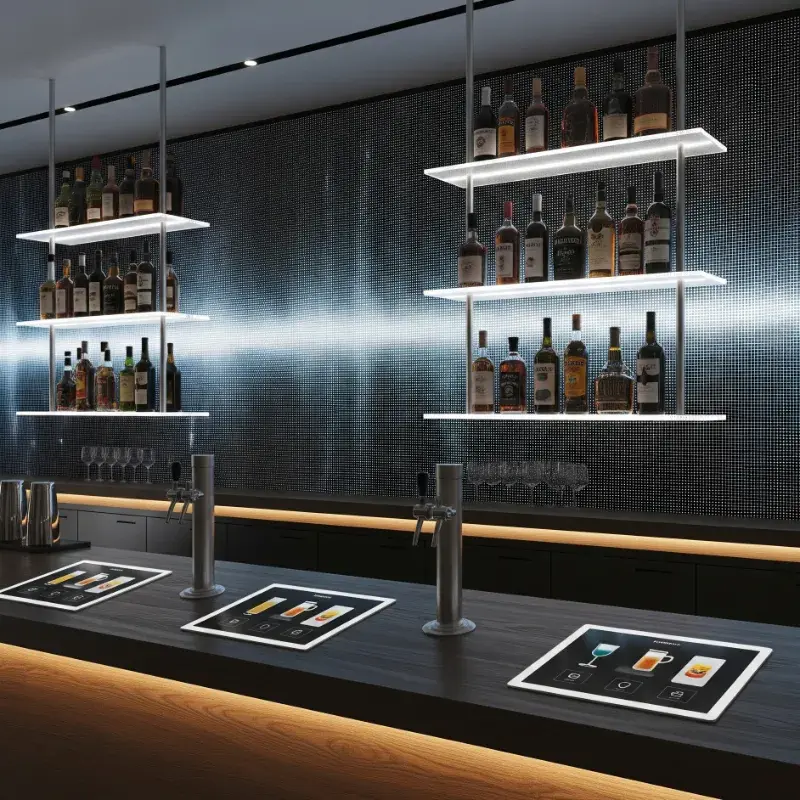
7. Vintage Sports Bar Revival
Reimagine the traditional sports bar with upscale vintage athletic club aesthetics that appeal to sophisticated sports fans. Think leather Chesterfield sofas, vintage sports memorabilia in museum-quality displays, and rich wood paneling reminiscent of old-school gentleman's clubs. Install multiple screens but frame them like artwork or hide them behind vintage-style cabinet doors that open during games. Create viewing nooks with tiered seating ensuring every seat has optimal sightlines. Display authentic vintage equipment like antique boxing gloves, leather footballs, and wooden tennis rackets as art pieces. Use brass fixtures, banker's lamps, and Persian rugs to elevate the atmosphere beyond typical sports bar expectations. Design a trophy room section with local sports history and rotating exhibits. This elevated approach attracts a more affluent demographic willing to pay premium prices for the refined experience while still delivering the excitement of live sports viewing.

8. Minimalist Japanese-Inspired Design
Channel the serene elegance of Japanese design principles to create a bar that offers respite from chaotic urban life. Embrace negative space, natural materials, and clean lines that promote calm and focus. Use a neutral color palette with occasional accent colors inspired by seasonal changes. Design low seating areas with cushions around sleek tables, and create intimate booth spaces using shoji-style screens. The bar itself becomes a stage for bartender performance, with every tool and bottle purposefully placed. Incorporate elements like a small zen garden, water features for ambient sound, and carefully curated artwork. Use indirect lighting through paper lanterns and hidden LED strips to create warm ambiance. This design philosophy extends to your menu presentation and service style, emphasizing quality over quantity. The minimalist approach reduces visual clutter, making small spaces feel larger while encouraging mindful drinking experiences.

9. Rooftop Bar Transformation
Convert unused rooftop space into a profitable oasis that offers escape from street-level noise and crowds. Design weather-resistant areas using retractable awnings, glass windbreaks, and heating elements for year-round operation. Create multiple zones: a covered bar area, open-air lounge spaces, and perhaps a small dance floor. Use modular furniture that can be reconfigured for private events. Install stunning lighting options from string lights creating a canopy effect to LED strips outlining architectural features. Consider adding greenery through planters and vertical gardens to soften hard surfaces. Design Instagram-worthy elements like neon signs against city skylines or unique sculpture installations. Address practical concerns like elevator access, safety railings disguised as design features, and proper drainage. Rooftop bars command premium prices due to their exclusive feel and views, making the initial investment highly profitable. The outdoor setting naturally encourages social distancing while maximizing capacity.

10. Steampunk Aesthetic Adventure
Dive into the fantastical world of steampunk design that combines Victorian elegance with industrial machinery for a truly unique atmosphere. Install exposed copper piping that serves both functional and decorative purposes, massive gear mechanisms as wall art, and vintage pressure gauges repurposed as design elements. Create custom furniture using leather, brass studs, and reclaimed wood with metal accents. Design elaborate contraptions for drink delivery, like pneumatic tube systems or mechanical arms. Use warm amber lighting through Edison bulbs in elaborate cage fixtures. Incorporate vintage maps, old blueprints, and antique scientific equipment as decor. The bar back becomes a laboratory-like showcase with apothecary bottles and curious instruments. Staff uniforms featuring goggles, vest chains, and arm garters complete the immersive experience. This theatrical approach attracts customers seeking unique experiences and provides endless conversation starters. The detailed environment encourages longer visits as customers discover new elements with each visit.

11. Local Heritage Storytelling
Transform your bar into a living museum celebrating local history and culture through thoughtful design choices. Research your building's past and neighborhood stories to create authentic connections. Display historical photographs showing your location's evolution, incorporate architectural elements salvaged from local buildings, and name drinks after local legends. Design different areas representing different eras of local history. Use materials sourced from regional suppliers and showcase local artisans' work. Create a timeline wall featuring significant local events. Partner with historical societies to ensure accuracy and potentially acquire unique artifacts. This approach builds strong community connections and attracts both locals proud of their heritage and tourists seeking authentic experiences. Design custom cocktail menus that tell stories through ingredients and presentations. The narrative-driven design creates emotional connections that transform customers into brand ambassadors who share your story with others.

12. Modular Furniture Systems
Invest in flexible, modular furniture systems that adapt to different needs throughout the day and week. Design custom pieces that transform: tables that adjust height from coffee to dining, benches with hidden storage, and moveable partitions that create intimate spaces or open floor plans. Use furniture on industrial casters for easy reconfiguration. Create modular bar sections that can expand during busy periods or contract for intimate gatherings. This flexibility allows you to host various events without permanent renovations: morning coffee service, afternoon coworking, evening cocktails, and late-night dancing. Choose durable materials that maintain appearance despite frequent movement. Color-code or number pieces for staff to quickly recreate specific configurations. This adaptability maximizes revenue by serving different customer segments throughout the day. The investment in quality modular systems pays off through increased functionality and reduced need for renovations as your business evolves.

13. Dramatic Lighting Design
Master the art of lighting design to create atmosphere, guide customer flow, and highlight architectural features. Layer different lighting types: ambient for overall mood, task lighting for functional areas, and accent lighting for visual interest. Install dimmer systems allowing atmosphere adjustments throughout service periods. Use statement fixtures like oversized pendant lights or custom neon installations as focal points. Create intimate zones with warm, low lighting while keeping bar areas brighter for safety and service efficiency. Incorporate color-changing LED systems for special events or themed nights. Design lighting that photographs well for social media, considering how phone cameras capture your space. Use uplighting to make spaces feel larger and downlighting for coziness. Hidden LED strips can outline architectural features or create floating effects for shelving. The right lighting design can transform an ordinary space into something magical while significantly impacting customer mood and spending behavior.
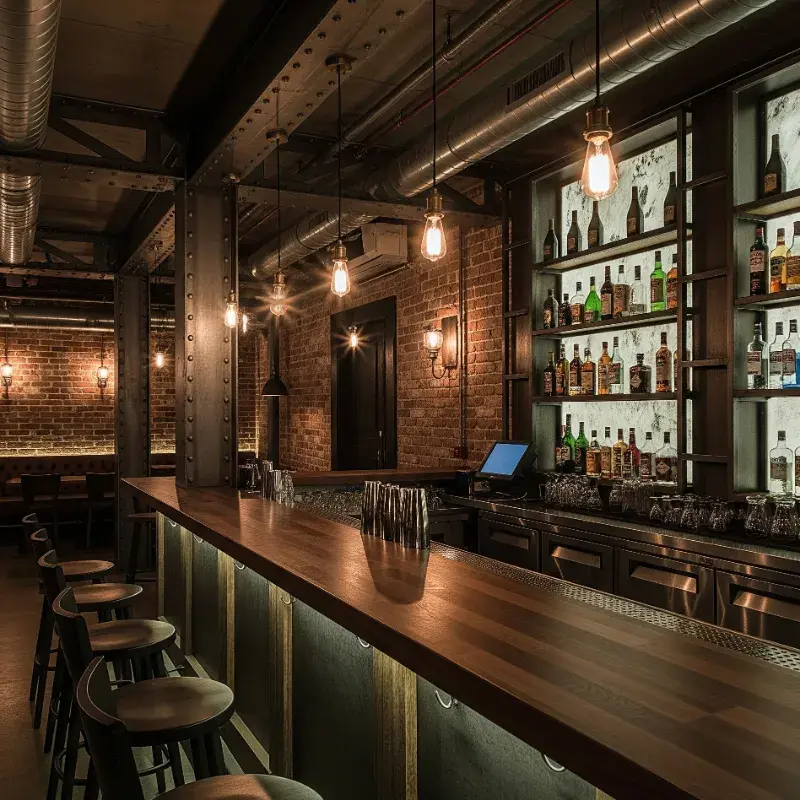
14. Acoustic Design Excellence
Address the critical but often overlooked element of acoustic design to create comfortable sound environments. Install sound-absorbing materials disguised as design features: decorative acoustic panels that look like artwork, fabric-wrapped panels integrated into wall designs, and acoustic ceiling treatments that appear purely aesthetic. Create sound zones using strategic placement of soft furnishings, plants, and partition screens. Design the bar area with materials that minimize glass and bottle noise. Position speakers strategically to ensure even sound distribution without dead spots or overwhelming volumes. Consider sound masking systems that use white noise to improve speech privacy in intimate seating areas. The goal is achieving the perfect balance where music enhances atmosphere without preventing conversation. Good acoustic design reduces customer fatigue, encourages longer stays, and receives positive reviews. This investment in comfort pays dividends through increased customer satisfaction and return visits.

15. Instagram-Worthy Photo Zones
Design specific areas optimized for social media photography that naturally market your venue through customer-generated content. Create a signature wall featuring unique textures, neon signs with clever phrases, or artistic murals by local artists. Install a flower wall, balloon installation, or other changeable backdrops that you update seasonally. Design bathroom spaces that surprise and delight with unexpected wallpaper, unique mirrors, or quotable wall text. You don't have to spend a fortune on upgrades that make it Instagram-worthy, just know the low-cost ways to renovate a bathroom. Ensure excellent lighting in these zones, considering how phone cameras perform. Position these features where they won't disrupt service flow but remain easily accessible. Create branded moments like custom neon signs with your bar's tagline or logo integrated artistically. The investment in photogenic design elements provides free marketing as customers share their experiences online. Track which features generate the most social media engagement and replicate successful elements. This strategy particularly resonates with younger demographics who consider social media shareability when choosing venues.

16. Sustainable Bar Design
Embrace sustainability as both an ethical choice and a powerful marketing tool by incorporating eco-friendly design elements throughout your space. Use reclaimed wood for furniture and fixtures, creating unique pieces with stories while reducing environmental impact. Install energy-efficient LED lighting systems and smart controls that adjust based on natural light and occupancy. Choose low-VOC paints and finishes that improve indoor air quality. Design systems for waste reduction: built-in recycling stations disguised as furniture, composting systems for organic waste, and water-saving fixtures. Source furniture and decor from local craftspeople to reduce transportation emissions while supporting the community. Create a green roof or garden space that provides ingredients for cocktails. Display your sustainability efforts through subtle signage that educates without preaching. This approach attracts environmentally conscious customers willing to pay premium prices for businesses aligning with their values. The long-term cost savings from efficient systems offset initial investments while building a positive brand reputation.
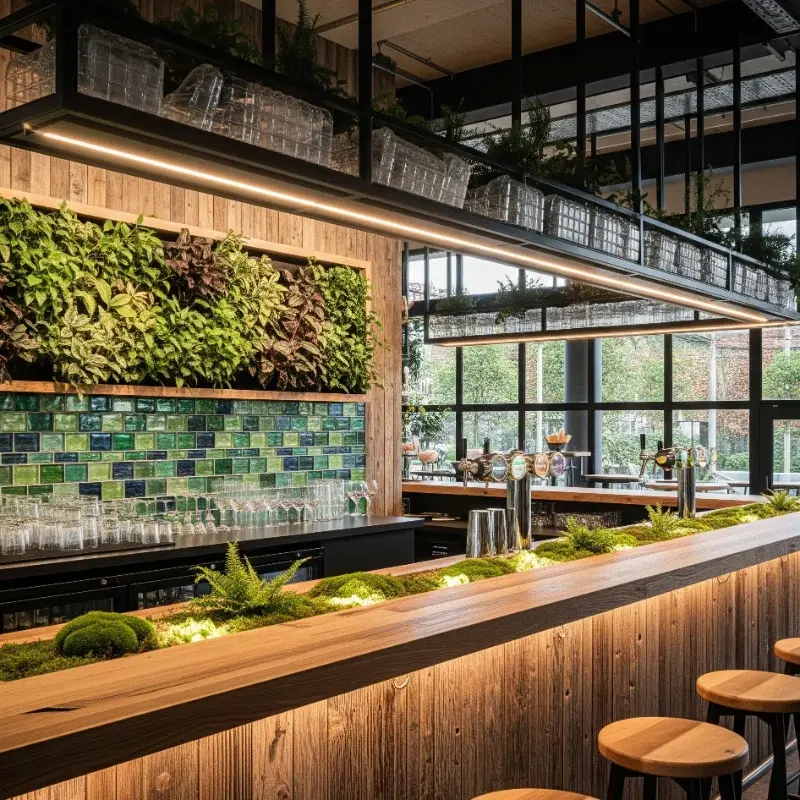
Conclusion
Your bar's design is more than aesthetics; it's a powerful business tool that drives customer behavior, builds brand identity, and ultimately impacts your bottom line. These 16 ideas offer starting points for creating spaces that photograph beautifully, function efficiently, and keep customers coming back. Remember, the best bar design authentically reflects your vision while serving your target market's desires. Start with one concept that resonates with your brand and build from there.
FAQs
Q1: What's the average ROI on bar design investments?
Well-executed design improvements typically generate 20-40% revenue increases within the first year.
Q2: Which design element impacts customer spending most?
Lighting design significantly influences mood, duration of stay, and average spending per customer.
Q3: How often should I update my bar's design?
Refresh minor elements annually, consider major updates every 5-7 years to stay current.
Q4: What's the most cost-effective design improvement?
Strategic lighting changes offer maximum impact for minimal investment, instantly transforming atmosphere.
Q5: Should I hire a professional designer or DIY?
Professional designers ensure code compliance and maximize ROI, making their fees worthwhile investments.
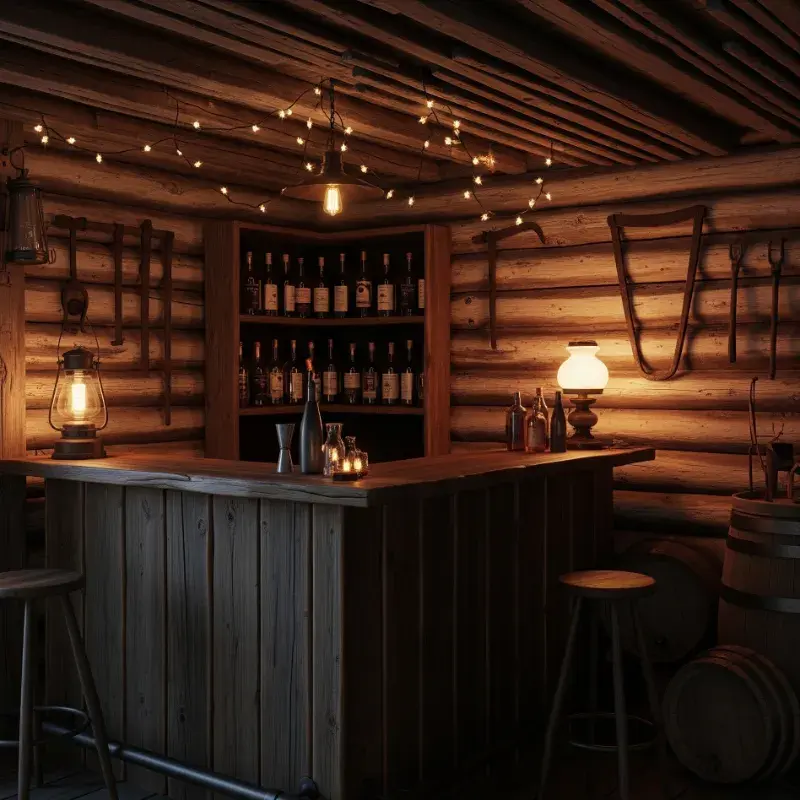


The bar design ideas shared here are really inspiring because every detail, from lighting to layout, can shape how people experience a space. I kept thinking about how design is very similar to building a business strategy — both require creativity, planning, and the right tools to stand out. For agencies, that often means finding ways to expand services without overwhelming the team. That’s one of the reasons I see private label seo as so valuable, since it allows agencies to deliver high-quality results while keeping focus on what makes them unique, much like a well-designed bar highlights its own character.
Creative bar designs can completely transform a space, making it inviting and memorable for customers. Every detail - from layout to lighting - plays a role in the overall experience. Behind the scenes, running a successful bar also requires organized operations and efficient workflows. That’s why many business owners rely on Docutrend for IT, print, and document solutions that streamline processes, keep information secure, and allow teams to focus on delivering exceptional customer experiences.